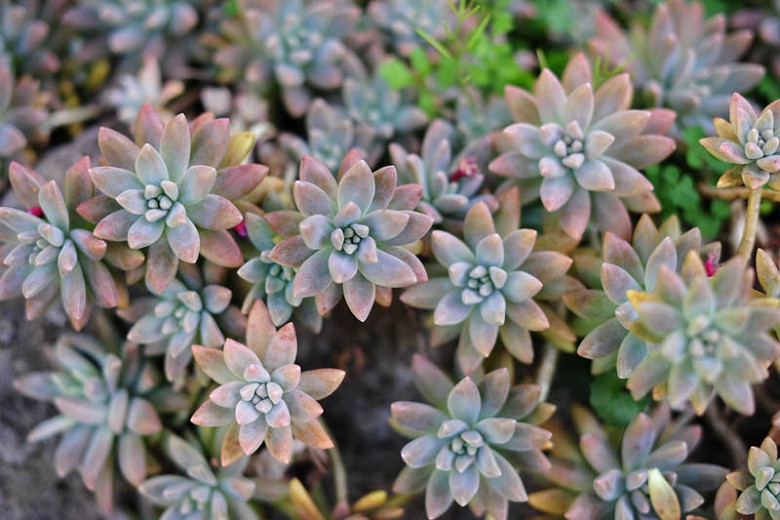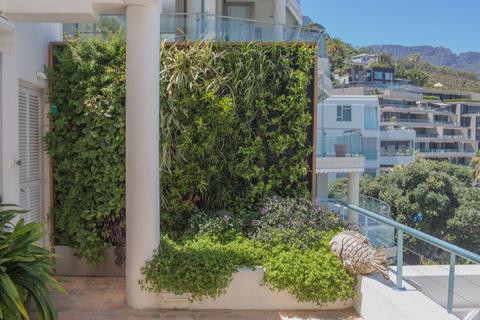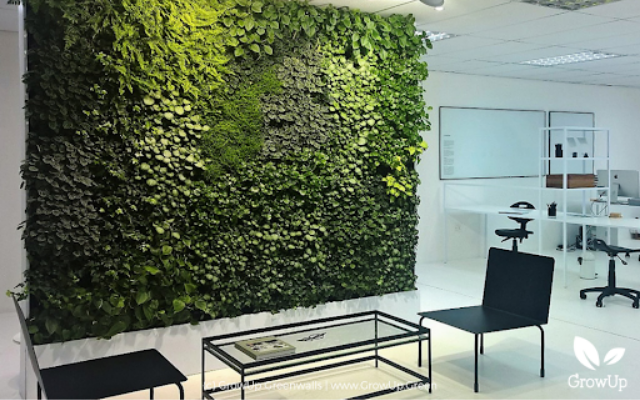Origin and Name
The Graptopetalum paraguayense is a lovely succulent known as the Ghost Plant or the Mother of Pearls Plant. The species sounds like it is from Paraguay, but the name is a misnomer. People initially planted the plant not in Paraguay, but in Mexico. One interesting fact, though, is that it appears no one has ever really discovered this plant growing in the wild. Researchers, however, believe it might have originated from Tamaulipas.
It is easy to grow succulents, requiring little maintenance on the grower's part. Let's dig into the care of Graptopetalum paraguayense.

Photo Credit: https://www.gardenia.net/plant/graptopetalum-paraguayense
Morphological characteristics
The Ghost Plant is a fleshy succulent of the family Crassulaceae. It is a dwarf plant growing to about 6 to 8 inches. The plant grows in a rosette pattern typical of plants in the Graptopetalum family. This small size makes it ideal for a green wall because it is not top-heavy. A top-heavy plant would be challenging to keep stable on the wall.
Foliage
The leaves of Graptopetalum peraguayense are why this plant is an everyday decor in many built environments globally. They come in various hues that range from pink and purple to yellow. The leaves add color and variety to the green wall. It is noteworthy that leaf color depends on exposure to sunlight, so if your wall has direct access to sunlight, your plant will be more colorful. It has a grayish silver color or a blue and green soft tone when in partial shade. The rosette formed by its leaves is usually about 6 inches in diameter.
The common name Ghost Plant comes from the pale appearance this plant can have. It is because the surface of the leaves is coated with a powdery substance called the farina. The whitish waxy farina is adapted to protect the plant from intense UV. It is one of the reasons this little succulent can withstand virtually any intensity of naturally occurring sunlight. This hardiness is excellent for the green wall; plants on an outdoor green wall are constantly exposed to the elements, and you want only to include plants that can withstand intense sunlight.
Flowers

Photo by @todoparatuhuerta via Pinterest
The plant has beautiful star-shaped yellow or white flowers; this shape of flowers is another typical characteristic of most plants in the Graptopetalum genus. It flowers during the spring and summer seasons, and the amount of sunlight available is a factor determining whether the plant will get to full bloom. While flowers may not be the plant's main attraction, the plant will give great beauty to your green wall in spring.
As a grower, you may come across Graptopetalum that is not flowering. This is an indication that the right conditions have not been provided. The flowers of the Graptopetalum are about 2cm in diameter.
Its flower arises from a woody flower stalk that appears at the beginning of a flowering season and withers at the end of flowering. The withered stalks from the previous flowering season can reduce the beauty of your plant, and removing them is one of the main routines in pruning you will have to observe when maintaining your green wall. Don't worry, though. The stalks are easy to remove, and this ease of pruning only makes Graptopetalum paraguayense even more ideal for your wall.
Toxicity
In addition to that, the plant is non-toxic to both human beings and pets. This is a significant plus because you don't need to sacrifice its visibility to keep it out of reach of children and pets. People like being near green walls due to the microclimates they create. Having toxic plants on a green wall would make it risky, and therefore, this plant is great for a green wall.
Stem
The stem of a healthy Graptopetalum paraguayense is short and erect. It doesn't grow beyond three inches, and it has some nodes. It has a grey-green hue. This is precisely the size of a green wall since there is no ample clearance between the plant and the wall. If you find the stem leggy or bending in one direction, the plant is experiencing a deficiency in lighting that you need to rectify. It is easy to keep the plant in check and the wall even.
Uses
This lovely succulent is a beautiful addition to your green wall. It has a compact base that accentuates its leaves' beauty; hence it would also look good in a hanging pot. Also, it is fantastic in office spaces.
Graptopetalum paraguayenese Care
This plant is not fussy. As we shall see below, it is pretty easy to take care of, which makes it ideal for the green wall in your environment.
Lighting and placement
This plant requires a lot of sunlight for its leaves to get bright color tones. For example, when the plant is subjected to full sunlight, its leaves are yellow. When in medium sunlight, they have a pink to purple color. When the graptopetalum is grown in partial shade, the leaves get a grayish silver tone.
For indoor graptopetalum, you must place the plant in a space that receives as much light as possible. An east-facing window is recommended for the plant's lighting needs because it allows the morning sun to land directly on its leaves. The western and southern windows also allow sunlight to fall on the plant. For best results, keep your plant within one foot of the window where it can soak in as much of the sunlight as possible.
It is important to note that the Graptopetalum paraguayense is a phototrophic plant meaning that: the plant is attracted to light. When it cannot gain full access to the light, the stem will elongate in the direction in which it can access the light, and they begin to trail. Hence trailing rosette is to be met with caution. It is not just a sign the plant is aging but a lack of adequate sunlight. A trailing Ghost Plant rosette undermines one of the plant's main points of attraction, its compactness. Of course, when it is trailing due to the lack of light, it won't allow the succulent to produce the hues of color.
Graptopetalum cannot handle low temperatures, and it is wise to bring them indoors during the cold winter months. This plant being indoors will also require 6 hours in the light. If You cannot find a well-lit space within your house, you may consider using grow lights. These artificial lights can help supplement your plants' lighting requirements.
Watering
The Graptopetalum paraguayense is a fleshy succulent and stores some water in its leaves. Drinking water is not a significant concern for this plant as the above adaptation enables it to survive periods of drought. The plant requires watering during the spring and summer months. This is a time when it is actively growing. The plant is to be watered once every two weeks. When watering, you have to be cautious to avoid overwatering this plant as it could lead to root rot.
How do you know it is time to water your Graptopetalum paraguayense? Using a two-inch test technique, determine whether your plant requires watering. This is done by inserting a finger into the soil to check whether the top two inches of the soil are dry. Don't water the plant if there is still moisture in the first two inches of the pottage because water from the previous drink is still in the soil.
You should avoid watering directly onto the leaves as this may cause them to be scorched when they contact the sun. Water on the leaves is likely to remove the white waxy substance from the leaves (flour), leaving the leaves without protection from UV. Therefore, it is advisable to water from the sides, so your green wall should have provision for that. The other reason to avoid watering the leaves is that the water might lodge on the rosettes and cause the leaves to rot. However, since the plant will be growing perpendicular to a green wall, the water would drain naturally from the rosettes.
Soil
The soil for planting ghost plants should drain well to allow the plant to aerate. Soggy and wet soil is not ideal as it results in root rot. Soil is relatively deficient in nutrients in the plant's natural habitat. Thus the main requirement is that its drainage is suitable for outdoor plants, not the nutrients.
A light porous potting mix with 50% sand, gravel, or perlite for indoor plants will provide your Graptopetalum paraguayense with the conditions necessary for its growth and avoid problems associated with overwatering. Having a bit of organic matter in the soil is helpful because it enables the soil to retain some moisture for the benefit of the plant. The organic matter also provides the little nourishment your Ghost Plant needs.
Fertilizer
This plant, like many others, requires to be fed when it eventually runs out of nutrients in its soil. Fertilize using a liquid-based fertilizer and dilute to half strength to avoid scorching the roots and a buildup of salts in the soil.
You should fertilize your plant when actively growing in the spring and summer. It takes a lot of energy for the plants to bloom, and thus you should feed the plant during flowering. To ensure the flowers bloom, the plant remains healthy as they bloom. More importantly, fertilize the plant once a month to avoid a buildup of salts in the soil.
Pruning and Grooming
This plant requires little maintenance on the grower's part. When the plant starts aging, and its rosette starts to trail off, you should take some care to maintain its beauty. You should be on the lookout for dead flower stalks, which you should pinch out immediately, as they do not have a purpose when the flower is not in bloom.
Pests and Diseases
Like all succulents, the ghost plant is prone to attacks from sap-sucking insects such as the mealybug and spider mites. These pests are usually found on the underlying side of a leaf. That is where they are likely to hide. As a grower, you should always be keen to check the leaves for any brown spots caused by these bugs. It would help if you were keen to look for these bugs and remove them from your plant before they infect the plant and cause its leaves to start dropping. So how do you keep your plant free from infestation? For already infected leaves, the remedy is to pinch them from the rosette. Use an organic insecticide such as pyrethrum and dilute it in water to avoid burning the leaves. Neem oil acts as a systemic pesticide that makes this plant unpalatable to pests. Applying this oil to the plant before it gets infected keeps pests at bay. You can also use liquid soap mixed with water to spray the pests.
Propagation
You can propagate this plant in three ways:
- Propagation by seeds
- Propagation by stem cuttings
- Propagation by leaf cuttings
It would help if you had the following things, so put them together before starting.
- A sharp cutting tool such as a knife or hand pruner
- Alcohol wipes, methylated or surgical spirit, and cotton wool
- Three-inch pots depending on the number of plants you want to propagate
- Well-drained soil
Propagation through seeds
You can propagate this plant by using seeds. However, the ghost plant is a slow grower, and it takes a long time for roots to form from the seeds. It is not a recommended method of propagation.
Propagation by stem cuttings
Propagation through stem cuttings is the easiest way to propagate this plant, and You must take the following steps to ensure a successful propagation.
- Obtain a stem cutting and let it dry for a day or so. Let the cut ends dry and callous. It is good to obtain cuttings from healthy-looking plants with plump leaves, not dehydrated ones or stressed plants.
- Dip the cut end in rooting hormone. Some people prefer using rooting hormones to speed up the process and guarantee success.
- Once the cut has healed and dried, stick the cuttings in a well-draining potting mix.
- Keep away from direct sunlight. Water the soil every few days or when it feels dry.
After about two weeks or so, you will notice new roots growing
Propagation by leaf cuttings
For a successful propagation by use of leaf cuttings, follow the following steps:
- Try to find a lovely plump leaf that looks healthy. Gently pull a leaf out; ensure you get the entire leaf, including the base. You should be able to twist the leaf off the plant gently, and it should come off quickly. It also helps to have more than one leaf because not all of them will make it to the end.
- Dip the cut ends in rooting hormone. Rooting hormones can help speed the propagation process when growing from leaves.
- Wait for the leaves to dry for about a day or two. Keep in a dry location away from direct sunlight.
- Prepare a well-draining potting mix. Once dry, lay the leaves flat on the soil or stick the cut ends in the soil.
- The leaves should start shooting out roots in about two weeks or so. You will notice a new baby plant in a few more weeks. The whole process can take anywhere from a few weeks to a month.
Conclusion
This plant is ideal for your green wall because it brings variety and color to the wall. The different colors from exposure to sunlight at different levels of intensity make the green wall beautiful. You may also have noticed that it is relatively easy to manage and it is therefore not a lot of work.




